by Marion Patterson | Mar 7, 2024 | Reflections/Profiles, Wonderment
Dupuytren’s Contracture: The Curse of the Vikings! Usually, we blog about nature and yards at Winding Pathways, but once in a while, we digress. This one’s about Rich’s Dupuytren’s adventure. But it is related to nature, as putting on gloves and manipulating his hand was becoming more difficult as two of his fingers began to curl. Also, genetics is nature.
Dupuytren’s Contracture is fairly common. It runs in families. The fingers on Rich’s Dad, Henry Patterson, curled so severely that manipulating tools, knobs, buttons, and eating utensils became difficult despite two surgeries to correct the condition.
Curse of the Vikings
So, what is it? Dupuytren’s Contracture was named for a French surgeon who described it first. It’s most common in men with Northern European ancestry, especially from Scandinavia and Scotland. That fits. Rich’s ancestors were from Denmark and Germany.
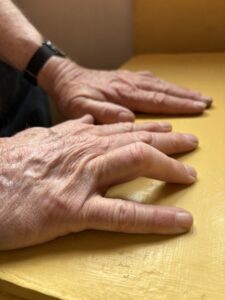
It’s caused when a knot of fascia forms under the skin usually in the palms beneath the ring finger and pinky. Sometimes a hard cord of material grows up the finger, forcing it to curl downward. Eventually, the finger can curl to about 90 degrees from the palm.
Women can get the condition, but less frequently than men, and often it’s not as severe.
Watchful
Rich first noticed a knot in his palm when he was 55 years old and gradually two of his fingers began to curl, making it impossible for them to lay flat on a table. There’s no way to predict whether Dupuytren’s will continue to grow or ever become a problem.
For many years Rich’s hand functioned normally with a slightly curved ring finger.
Doing Something About This
About two years ago he visited Dr. Clifford Novak, a hand surgeon at Cedar Rapids’ Physicians Clinic of Iowa. He encouraged Rich to return if the condition worsened or interfered with everyday activities. It started to, so in mid-2023 he again visited Dr. Novak and learned of three possible treatments: surgery to remove the material, needle aponeurotomy to cut the long cord causing the curl, and chemical treatment.
Because his condition was not profound and recovery sounded the easiest, he chose the needle method.
Surgery
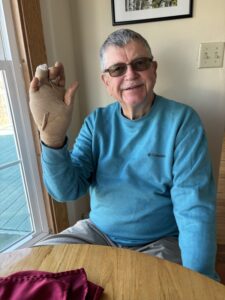
The hand was bandaged for four days.
On February 23, 2023, Dr. Novak performed the surgery. Rich stayed in the outpatient Surgery Center for just four hours. He left with his hand heavily bandaged, making typing and any other form of manipulation difficult….but for only four days. On February 27th a physical therapist removed the bandages and gave Rich a series of exercises to help straighten the finger. Amazingly there were no sores or scars where the needles were inserted. For the first time in several years, he could lay all his fingers flat on a table. There was no pain. The result is amazing.
Follow-Up
There’s no assurance the Dupuytren won’t grow back in the same finger or progress in other fingers, but the surgery was so successful it could be repeated if needed.
Dr. Novak’s advice was to treat the curled finger BEFORE it became difficult to use.
Rich did this with success as these after photos reveal.
-
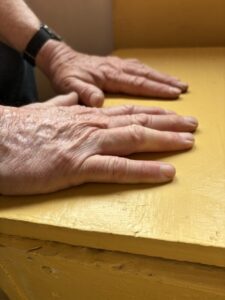
-
Improved straightened finger.
-
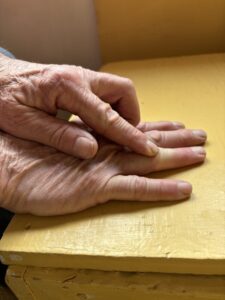
-
Exercises are simple and critical to recovering use of the finger.
by Winding Pathways | Feb 1, 2024 | Reflections/Profiles
Phone Call Sets In Motion Action
In early 2005 Rich received an attention-grabbing phone call that set in motion a prostate Cancer Adventure.
“Are you sitting down?” Dr. Rippentrop asked. “Yup,” Rich replied. “You have prostate cancer. Come to my office tomorrow and bring Marion. I’m going to give you options,” he said.
A cancer physician with a robust sense of humor is worth his or her weight in gold, and Dr. Jon Rippentrop shared his wondrous humor that’s stacked on solid medical credentials. As we sat nervously in his office he winked and said, “You have no symptoms and feel good. You don’t need to do anything about your prostate cancer……and the good news is you won’t have to do any retirement planning!!!!” We chuckled at his humor because we knew he was about to give us hopeful options.
Treatments
Then he presented several possible treatments for this prostate cancer adventure. We chose to proceed quickly with surgery and, later, radiation. On December 27, nearly 18 full years after his prostate was removed Rich had a semiannual meeting with Dr. Rippentrop. Rich’s PSA test showed undetectable. “Looks great!” said the doctor.
Science works. Wise researchers developed the PSA test and our astute family doctor noted Rich’s rising psa during annual blood tests before physicals. She referred him to urologist surgeon Dr. Rippentrop, who conducted robotic surgery. It worked.
Rich has enjoyed good health all these years and is appreciative of the outstanding science and wise physicians who helped him along his cancer journey. Fortunately, prostate cancer, like some other cancers, responds well to early detection and treatment.
Back Sliding in Receptivity to Scientific Knowledge
Modern medicine is amazing but there is sad news. Charles Kenny’s relatively new book, THE PLAGUE CYCLE, is a history of how medical researchers learned to prevent or cure many contagious diseases that felled millions of people in years not far back. Both Rich and Marion remember receiving the then newly developed polio vaccine they took as children. Certainly, their parents were appreciative of the new vaccine. The polio scourge that struck so many children is now virtually unknown. Thanks to science. While cancer is different from microbes that spawn contagious diseases, scientific advancements over decades help ALL live healthy lives. Sometimes we take this for granted.
Kenny’s last chapter reveals disturbing medical backsliding. Far too many people believe Internet hucksters who plant unfounded fear of modern medical treatments and vaccines.
Ruining Everyone’s Day
A diagnosis of a disease or contagion alters people’s lives. Avoiding vaccinations puts lives at unnecessary risk.
Prostate cancer isn’t caused by a microbe and has no symptoms in its early stage. The PSA test helps a physician identify and treat it using a variety of techniques while there’s still time. It’s a lifesaver.
Winding Pathways owners Marion and Rich Patterson urge everyone to get annual physicals, appropriate medical tests, and vaccinations.
by Winding Pathways | Jan 25, 2024 | Nature, Reflections/Profiles
Lots to Experience in January
(reworked from the Patterson’s “Iowa’s Wild Side” column
originally in the Cedar Rapids Gazette)
Winter in Iowa is erratic. Mild. January thaws. Grey, damp, and achy mornings. Frigid. Blustery. Sunny, sparkling days when all is right. We have it all. Here are ways we a find joy in January.
Some people escape to warmer regions. Most of us hang tough and grumble. At Winding Pathways, we’ve found that simple observations can enliven and deepen our appreciation for the change of seasons.
Sit Still
Bundled up in his Carharts and sitting quietly downwind at dusk, Rich notices deer begin to move. Stars and planets glow. Five geese honk and wing across the waxing moon. A photographer’s dream. An owl’s call fills the stillness left behind.
Wildlife freeze as the great horned owl’s ghostly shape floats silently to a branch near our home. Puffed to twice its size, a buffer against the cold, it waits. Several long minutes pass. Then, a rabbit cautiously emerges from the prairie stubble. An opossum noses hungrily at the compost heap. A startled mouse scurries across an open space. With talons extended and yellow eyes gleaming, the owl drops. After a brief scuffle, only bits of fur remain.
-
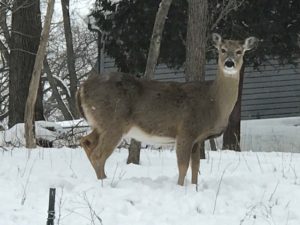
-
Inquisitive doe.
-
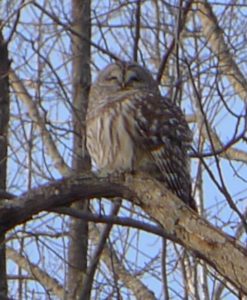
-
Waiting
-
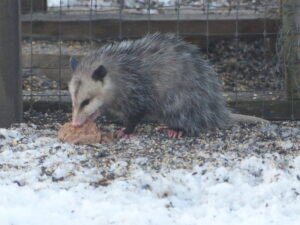
-
Possums’ feet help it climb.
Observe When You Drive
Another way we find Joy in January is by taking drives. Across a frosty Iowa road, we slow as four deer race across a field, leap a barbed wire fence, and dash to safety beyond busy Highway 30. We speculate what startled them. A short time later we observe a face-off between a grazing cow and a foraging hawk. Neck stretched out, nose to the wind, the cow eyes the hovering hawk.
From the comfort of our home, we watch birds. Siskins, when the weather is cold, Carolina wrens when winters are mild, hang around the feeder and shrubs loaded with berries. A red-headed woodpecker pecks at suet. It rattles noisily and jabs its lance-like bill at the less aggressive birds. Its strong bill is great for hammering insects out of frozen trees and pounding holes in ice-encased water baths.
January Ice
Black ice is another winter phenomenon. While not fun to drive on it is intriguing on rivers, ponds, and lakes. One Kansas winter an Arctic airmass plunged into the heartland and gave us a chance to peer into the dark depths below. A snapping turtle slowly swam through the thick water. Ice skaters reveled in the unusual event.
Nowadays we enjoy Arctic air from the inside. A small pool is just outside our window near the feeders. Sometimes, when temperatures drop quickly, and black ice forms we can see “through the looking glass” so to speak. A small aerator keeps a circle of water open. Small birds hop to the edge and drink. The overwintering goldfish appreciate the extra O2.
And we enjoy hot chocolate during January’s dormant month.
by Winding Pathways | Dec 28, 2023 | Reflections/Profiles
Responding
While working on my computer in the early evening of December 15th I (Rich) heard a loud crash from nearby 30th Street Drive and felt the cabin shudder. My first reation was, must be a car-deer collision. Grabbing my flashlight, I dashed out and found two mangled cars. A head-on collision.
Fearing casualties, I was quickly relieved to find one driver and her small child standing by the car shaken and apparently uninjured. The driver of the other car had a small leg wound that didn’t seem to need immediate attention. After calling 911, I directed traffic away from the smashed cars and rattled people.
Witnessing Tax Dollars At Work
Soon, the Marion Fire Department, a Linn County Deputy Sheriff, and the Area Ambulance Agency arrived. My role switched to being an observer. I was pleased to watch about a dozen people from three agencies coordinate rescue and clean up. One agency parked the firetruck across the road to prevent other drivers from coming through. Others gave immediate attention to the people involved and examined and assessed the cars and situation. As others tended to the people one man swept up the debris and spilled antifreeze, while another took photos, and others continued to direct traffic.
It was well done. Our Tax Dollars at work! I have heard nothing since but hope the people involved in the accident are OK.
Here are my takeaways:
- Airbags and seat belts are lifesavers. The airbags in both cars inflated almost instantly.
- I believe the child had been securely strapped in a car seat in the back seat……..another lifesaver.
- Emergency responders are well-trained, fast, and coordinate perfectly with first responders from other supporting agencies.
- Traffic laws have a reason. Drive the speed limit or a tad slower. Pay attention. Buckle up.
Appreciation
Thanks, first responders!
by Winding Pathways | Jul 20, 2023 | Reflections/Profiles, Uncategorized, Weeds
Wisdom From “Johnny Appleseed” of Prairie Plants
“Weeds are mother nature’s stitches,” prairie restorationist Corliss “Jock” Ingels told us years ago.
“If you badly cut yourself, a physician stitches the wound closed so it can heal. If you bare the ground, weeds quickly sprout, shading the soil with foliage and filling it with roots. Weeds reduce erosion until more permanent plants take hold,” he proclaimed.
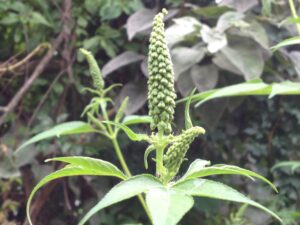
Even rag weed has a purpose. Birds love the seeds.
On a hot summer morning, we pedaled along the Grant Wood Trail, seeing mother nature’s stitches alongside the new pavement. Recently the popular bicycle trail was paved. Machines bared the soil at the edge of the pavement that’s now covered with bright yellow trefoil, crown and purple vetch, golden dandelions, white spurge, sweet clover, ragweed, and poison hemlock. All are so-called invasive weeds, but they’re providing a service by holding the soil and giving homes to trailside wildlife until more “desirable” plants establish. Some of those pioneering weeds sported an array of bright flowers that made our morning ride delightful.
Beyond Human Centric
Weeds have a purpose, but must a plant or animal need to have a “human-centric” perspective?
The night before our bike ride we sat on our back deck with Neil and Renata Bernstein. He’s a recently retired biology professor and remarked that sometimes people ask what purpose a particular plant or animal has.
Purpose! Must plants and animals have a purpose from a human perspective?
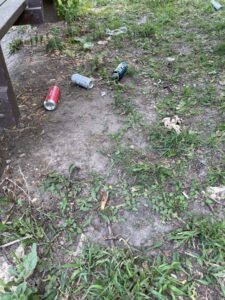
Easily recycled cans become trash.
Dr. Bernstein sometimes responds to these questions by saying, “What’s the purpose of people?” Indeed, our observations are that modern humans have forced out original people from their lands. We have done a great deal of harm by polluting the air, siphoning off life-giving water to maintain green grass, and stripping the land of topsoil, precious metals, and crystals. We greedily take a resource, convert it to our own purpose, then throw it away. “What’s the purpose of people?”
More to Purpose Than Our Perspective
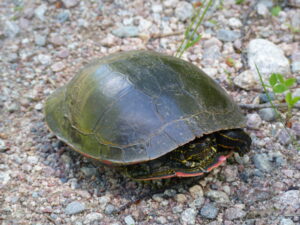
We can learn much from turtles.
Some living things certainly have a great purpose. Without wheat, cattle, corn, penicillin mold, lumber, trees, and thousands of other plants and animals we couldn’t live. Others may seem to have a negative purpose. Think disease-causing microbes, poison ivy, ragweed that spews allergic pollen into the air, mosquitoes, and a host of other creatures that cause human misery. To view them negatively is human-centric.
The vast majority of living things neither produce tangible benefits nor problems for people. Like turtles, they simply live. Probably they have a valuable ecological role that may not be obvious but they are here. They have a right to be here whether or not they provide human impact. As we have learned over millennia, different plants and animals, offer benefits to us. We simply have to observe and incorporate.
To Everything…There is a Purpose
Every living thing has a purpose in the great scheme of things that people barely understand.
So, as we cycle along, we doff our bike helmets to the diversity of life we pass and silently thank them for sharing the world with us.
by Winding Pathways | Jun 15, 2023 | Nature, Reflections/Profiles, Wonderment
Sitting: it’s a rewarding outdoor activity. How can that be when everyone knows that being outdoors means movement? Hiking, cycling, skiing, canoeing, and swimming all get the heart beating and muscles working.
-
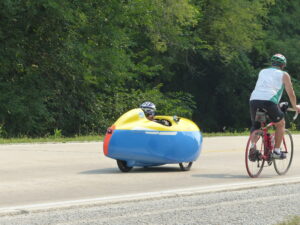
-
You see everything on RAGBRAI
-
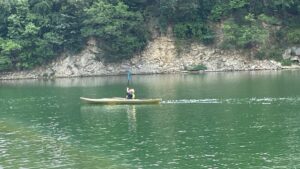
-
Kayaking gets the heart pumping and strengthens the arms
We love all these activities but recently were reminded that sitting quietly is a fascinating and productive way to spend time outdoors. On a gorgeous May morning, we stopped at the road’s end in Iowa’s Brush Creek Canyon Nature Preserve. A narrow informal path lured us past a rock outcropping high above a gurgling brook.
We carried the sling chairs and binoculars that we keep in the car down a narrow informal footpath. Just a hundred yards later we found a level spot with a perfect view downward through trees to the water.
Sit we did. Enmeshed in secluded quiet we sat so still that warblers and vireos flitted among the trees. Even a hummingbird buzzed in front of us. A fly settled on Rich’s pants, explored a bit, and then went on its way.
Active outdoor activities are good for the body and mind, but sometimes sitting is the best way to notice our world and its inhabitants. When we scurry down a trail, wildlife hides or flees. When we sit and become part of the landscape, wildlife ignores the human presence and goes about its business.
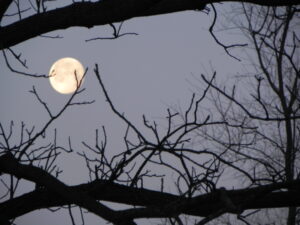
Tree branches help you watch the moon move across the sky.
Here’s our favorite sitting exercise that can be done almost anywhere. As a full moon rises, position a comfortable chair with tree branches or even overhead wires between it and the moon. Sit very still. Using branches or the wire as a reference it’s possible to watch the moon move.
Oh, Brush Creek Canyon. We recommend it as one of Iowa’s wildest natural gems. It’s just north of Arlington in Fayette County. Go outside. Have fun.
-
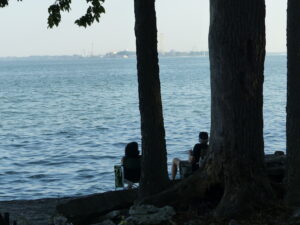
-
Couple by lake
-
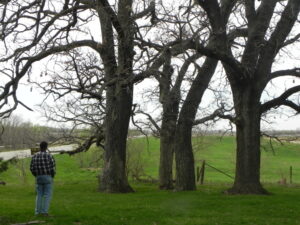
-
Wonderment
-
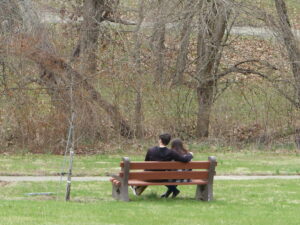
-
Finding peace
















